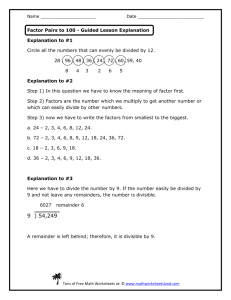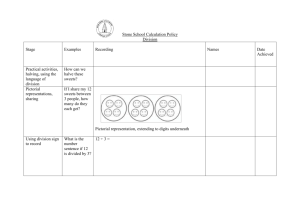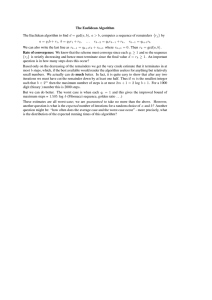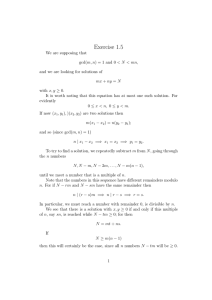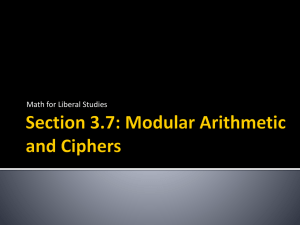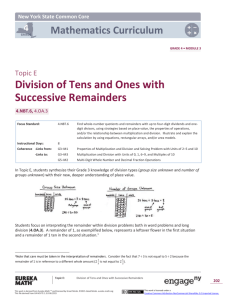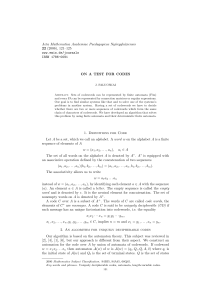Acta Mathematica Academiae Paedagogicae Ny´ıregyh´ aziensis (2008), 249–256 24
advertisement
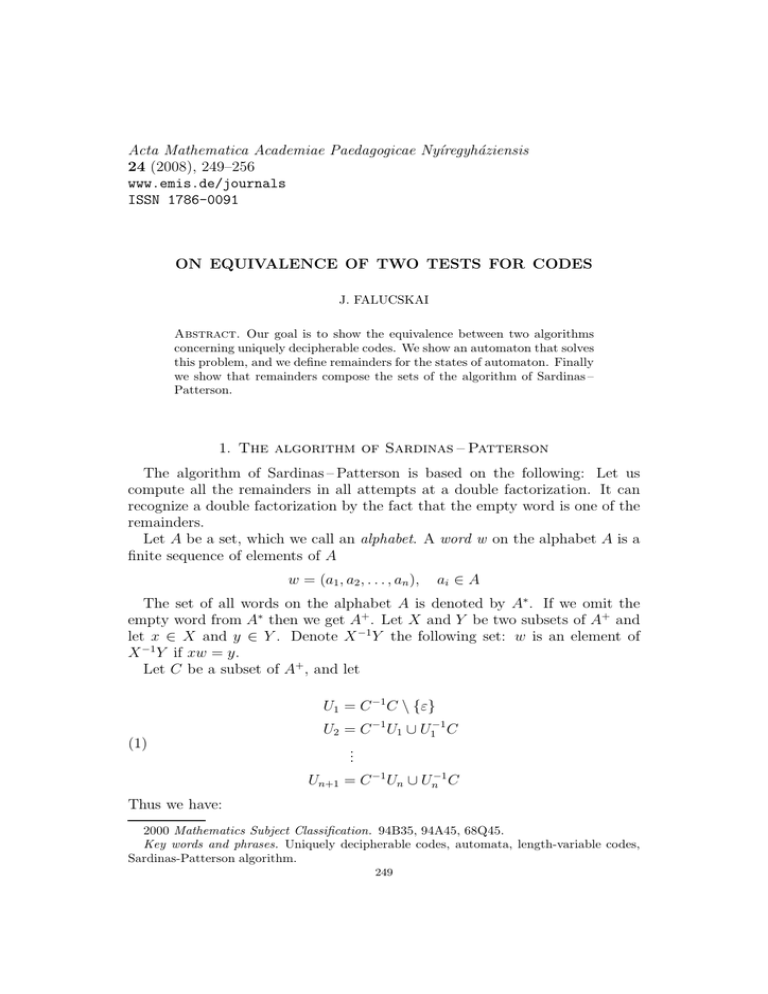
Acta Mathematica Academiae Paedagogicae Nyı́regyháziensis
24 (2008), 249–256
www.emis.de/journals
ISSN 1786-0091
ON EQUIVALENCE OF TWO TESTS FOR CODES
J. FALUCSKAI
Abstract. Our goal is to show the equivalence between two algorithms
concerning uniquely decipherable codes. We show an automaton that solves
this problem, and we define remainders for the states of automaton. Finally
we show that remainders compose the sets of the algorithm of Sardinas –
Patterson.
1. The algorithm of Sardinas – Patterson
The algorithm of Sardinas – Patterson is based on the following: Let us
compute all the remainders in all attempts at a double factorization. It can
recognize a double factorization by the fact that the empty word is one of the
remainders.
Let A be a set, which we call an alphabet. A word w on the alphabet A is a
finite sequence of elements of A
w = (a1 , a2 , . . . , an ),
ai ∈ A
The set of all words on the alphabet A is denoted by A∗ . If we omit the
empty word from A∗ then we get A+ . Let X and Y be two subsets of A+ and
let x ∈ X and y ∈ Y . Denote X −1 Y the following set: w is an element of
X −1 Y if xw = y.
Let C be a subset of A+ , and let
U1 = C −1 C \ {ε}
(1)
U2 = C −1 U1 ∪ U1−1 C
..
.
Un+1 = C −1 Un ∪ Un−1 C
Thus we have:
2000 Mathematics Subject Classification. 94B35, 94A45, 68Q45.
Key words and phrases. Uniquely decipherable codes, automata, length-variable codes,
Sardinas-Patterson algorithm.
249
250
J. FALUCSKAI
Theorem 1 ([2]). Let C ⊂ A+ and let (Un )n≥1 be defined as above. For all
n ≥ 1 and k ∈ {1, . . . , n}, we have ε ∈ Un if and only if there exists a word
u ∈ Uk and integers i, j ≥ 0 such that
(2)
uC i ∩ C j 6= 0,
i+j+k =n
Proof. ([2]) We prove the statement for all n by descending induction on k.
Assume, first k = n. If ε ∈ Un , taking u = 1, i = j = 0, the equation above
is satisfied. Conversely, if (2) holds, then i = j = 0. This implies u = 1 and
consequently ε ∈ Un . Now let n > k, and suppose that the equivalence holds
for n, n − 1, . . . , k + 1. If ε ∈ Un , then by induction hypothesis, there exists
v ∈ Uk+1 and two integers i, j ≥ 0 such that
uC i ∩ C j 6= 0,
i
i+j+k+1=n
j
Thus there are words x ∈ C ; y ∈ C such that vx = y. Now v ∈ Uk+1 , and
there are two cases. Either there is a word z ∈ C such that
zv = u ∈ Uk
or there exists z ∈ C; u ∈ Uk such that
z = uv
In the first case, one has ux = zy, thus
uC i ∩ C j+1 6= 0, u ∈ Uk
In the second case, one has zx = uvx = uy, thus
uC j ∩ C i+1 6= 0, u ∈ Ck
In both cases, formula (2) is satisfied. Conversely, assume that there are u ∈ Uk
and i, j ≥ 0 with
uC i ∩ C j 6= 0,
i+j+k+1=n
Then
ux1 x2 . . . xi = y1 y2 . . . yj
for some xr , ys ∈ C. If j = 0, then i = 0 and k = n. Thus j ≥ 1. Once more,
we distinguish two cases, according to the length of u compared to the length
of y1 . If u = y1 v for some v ∈ A+ , then v ∈ C −1 Uk ⊂ Uk+1 and further
vx1 x2 . . . xi = y2 . . . yj
Thus vC i ∩ C j−1 6= 0 and by the induction hypothesis ε ∈ Un . If y1 = uv for
some v ∈ A+ , then v ∈ Uk−1 C ⊂ Uk+1 and
x1 x2 . . . xi = vy1 y2 . . . yj
showing that C i ∩ vC j−1 6= 0. Thus again ε ∈ Un by the induction hypothesis.
This concludes the proof.
Theorem 2 ([2]). The set C ⊂ A+ is a uniquely decipherable code if and only
if none of the sets Un defined above contains the empty word.
ON EQUIVALENCE OF TWO TESTS FOR CODES
251
Proof. ([2]) The proof of theorem is based on the previous lemma. If X is not
a code, then there is a relation
x1 x2 . . . xn = y1 y2 . . . ym ; xi , yj ∈ C; x1 6= y1
Assume |y1 | < |x1 |. Then x1 = y1 u for some u ∈ A+ . But then
u ∈ U1 and uC n−1 ∩ C m−1 6= 0
According to the lemma, ε ∈ Un+m−1 . Conversely, if ε ∈ Un , take k = 1 in the
lemma. There exists u ∈ U1 and integers i, j ≥ 0, such that uC i ∩ C j 6= 0.
Now u ∈ U1 implies that xu = y for some x, y ∈ C. Furthermore x 6= y since
u 6= ε. It follows from xuC i ∩ xC j 6= 0 that yC i ∩ xC j 6= 0, showing that C is
not a code. This establishes the theorem.
Our goal is to show the equivalence between the Sardinas - Patterson algorithm and the following algorithm:
2. An automaton to test codes
We construct an automaton for the code over A by union of automata of
codewords. If w = x1 x2 . . . xn is a codeword then the automaton A(w) of
codeword w is A(w) = (Q, qi , Qt , A, δ) where qi is the initial state of A(w) and
Qt is the set of terminal states. Q is the set of states and Qt = {qi }; qi ∈ Q;
card(Q) = length(w) since the rules of automaton A(w) are the following:
δ(qi , x1 ) = qx1
δ(qx1 , x2 ) = qx1 x2
..
.
δ(qx1 x2 ...xn−2 , xn−1 ) = qx1 x2 ...xn−2 xn−1
δ(qx1 x2 ...xn−1 , xn ) = qi
thus, A(w) can recognize w ∗ .
If we join the automata of codewords, then we get the automaton
A(w1 , . . . , wn )
of code C = {w1 , . . . , wn }. We can use notation A(C), too. So
A(C) = (Q = Qw1 ∪ · · · ∪ Qwn , qi , Qt = {qi }, A, δ = δ w1 ∪ · · · ∪ δ wn )
Obviously, A(C) accepts C ∗ . An automaton is non deterministic if there is
more then one rule for the same pair of state and symbol.
If a string S decipherable on code C then A(C) accepts S, namely A(C)
read it and stay in qi state. If S is not uniquely decipherable then we can follow
different paths during reading. We join these different paths by the equivalent
252
J. FALUCSKAI
deterministic automaton. Formally
wj
wj
}|1
{ z
}|n
{
z
x1 . . . x|wi | . . . x|wj | . . . . . . . . . . . . . . . x|S|
1
| {z }
| {z 1}
wim
wi1
δ(qi , x1 ) = qx1
δ(qx1 , x2 ) = qx1 x2
..
.
δ(qx1 x2 ...x|wi
1
|−1
, x|wi1 | ) = {qx1 x2 ...x|wi | , qi }
1
δ({qx1 x2 ...x|wi | , qi }, x|wi1 |+1 ) = {qx1 x2 ...x|wi
1
1
|+1
, qx|wi
1
|+1
}
..
.
δ({qx1 x2 ...x|wj
1
|−1
, qx|wi
1
|+1 ...x|wj |−1
1
}, x|wj1 | ) = {qi , qx|wi
1
|+1 ...x|wj |
1
}
..
.
δ({qx|wj
n
|+1 ...x|S|−1
, qx|wi
m
|+1 ...x|S|−1
}, x|S| ) = {qi , qi } = qi
Thus two (or more) factorizations of a string will be ended by using two (or
more) rules with right side qi .
Theorem 3. A code is uniquely decipherable if and only if at the most one
state equal to qi in right side of any rule of AD (C) , namely
∀ δ({qi1 , . . . , qin }, x) = {qj1 , . . . , qjm } ∈ AD (C) :6 ∃ l, k : qjl = qjk = qi
3. The equivalence
As we wrote, the algorithm of Sardinas – Patterson is based on the remainders of double factorization.
S
By equation (1) it is in evidence that the set U = ni=1 Ui contains every
remainder. The definition is recursive, but in the case of infinity recursion
card(U) ≤ k ∈ N, since the length of any remainder is less than that of the
longest codeword. In non deterministic automaton A(C) a remainder appears
in the following way: If wi1 . . . win α = wj1 . . . wjm i.e. wi1 . . . win = x1 x2 . . . xn ;
wi ...win
wj1 . . . wjm = x1 x2 . . . xn xn+1 . . . xm ; α = xn+1 . . . xm then qi −−1−−−→ qi and
wj ...wjm
α
→ qi (α 6∈ C), so there have to be
qi −−1−−−→ qi . There is no way such that qi −
wi ...win
α
→ qi . So in AD (C) there is
another way qi −−1−−−→ qx ; qx 6= qi and a way qx −
a state which contains both qx and qi . If we link the touched symbols by the
way from qx to qi in automaton A(C), then we obtain the remainder α.
Generally we can say that: If a state of AD (C) contains qi then mate states
of qi will show remainders. If qi is accessible by different ways from a state
in A(C), then the state will generate more remainders. It is advisable to
ON EQUIVALENCE OF TWO TESTS FOR CODES
253
indicate all possible remainders of all states of A(C). After this notation we
can receive remainders directly from the names of states which appearing with
qi in AD (C). Let R(q) denote the set of remainders of state q of A(C), and
let Ui the sets of Sardinas – Patterson algorithm.
S
Corollary 1. ni=1 Ui = {R(qx ) | {qx , qi } ⊆ q of AD (C)}
Example 1. Let C = {010, 1101, 10, 11}. Thus we get A(010, 1101, 10, 11)
in Figure 1. (qi = S). Computing R(q) for all states of A(C) we receive the
following table. It is very easy to compute the remainders of a state q, since
if we follow all the way from state q to qi we will get them. Now qi = S. In
this case we do not write the remainder of S because it is ε for all time. We
obtain ε as a remainder if and only if there is a state of AD (C) that contains
two (or more) S during the generation, as we mentioned above. (See the rule
δ({B, C}, 0) = {S, S}) of AD (C) for this case). If S is accessible by different
ways from a state q in A(C), then the state q generates more remainders. We
can see an example for this in the case of state C. The table of remainders is
the following:
State Remainders
A
10
0
B
C
1, 0, 101
D
01
E
1
Table 1. Remainders of A(010, 1101, 10, 11)
Figure 1. Automaton A(010, 1101, 10, 11)
Let us construct AD (010, 1101, 10, 11). The result is given in Figure 2. We
can see that
δ({B, C}, 0) = {S, S} = {S}
so ε is one of the remainders (in that case the code is not uniquely decipherable).
254
J. FALUCSKAI
Figure 2. Automaton AD (010, 1101, 10, 11)
Finally we give those states, which appear together with S in a common
states of AD (C): {A, B, D, S}. So the possible remainders are the following:
{01, 0, 10, ε}. We get the same result by Sardinas – Patterson algorithm:
U1 = {01} U2 = {0} U3 = {10} U4 = {ε}
so
S
Ui = {01, 0, 10, ε}.
We can show a closer relationship between the automaton and the Sardinas –
Patterson algorithm. We can realize from the definition of the set Ui that its
elements derive from two strings, which contain whole codewords in all i piece.
(Except the case of ε, since the number of codewords is i+1.) In AD (C) we can
receive the number of codewords from the number of touched S. Unfortunately
it is not sufficient, because of the following strings
wi1 . . . wik wik+1 . . . win α = wj1 . . . wjk wjk+1 . . . wjm ;
∀ 1≤l≤k:
il = jl
If we ignore the prefix parts of strings, then we obtain the right subscript for
U. Formally it looks like that
n + m − 2k
if α 6= ε
(3)
i=
n + m − 2k − 1 if α = ε
So we have to regard the touched codewords for every state. Of course we
can get a state by different ways, so more codeword sequences could belong
to a state. Let the codewords be indicated by their last touched state and
the symbol before S. For example in Figure 1 the notation of codeword 010
0
1
0
is B0 , since S −
→A−
→B −
→ S. If we give the possible touched sequences of
codewords for all states which appear together with S in common states of
AD (C), then we get index of Ui by (3). We obtain the remainder by the table
of remainders.
ON EQUIVALENCE OF TWO TESTS FOR CODES
255
Example 2. If C = {010, 1101, 10, 11} then we receive the following table from
AD (C). We do not have to write all possible touched sequences of codewords
for the states, since it is in evidence by (3) that the index of Ui is the same
for all sequences for a state. For the state pair (S, A) the remainder is 10
State
Touched codewords
S
C1 B0
C1 C1 B0
E1 C1 B0
A
E1
C1 E1
E1 E1
S
E1
C1 E1
E1 E1
B
C1
C1 C1
E1 C1
S
C1
C1 C1
C1 E1 C1
D
−
C1
C1 E1
S
E1 B0
C1 E1 B0
E1 E1 B0
S
C1 B0 C0 C1 C1 B0 C0 E1 C1 B0 C0
Table 2. Some touched sequences of codewords in AD (010, 1101, 10, 11)
(see the table of remainders, where 10 belongs to A), and the index is 3,
since length(C1 B0 ) + length(E1 ) = 2 + 1 − 2 ∗ 0 = 3 (see (3)). We get 3 for
C1 C1 B0 , C1 E1 as well: length(C1 C1 B0 ) + length(C1 E1 ) = 3 + 2 − 2 ∗ 1 = 3,
since they have common prefix part, whose length is 1. We have to mention
the state pair (S, S). The remainder is ε, (we did not give the remainder
of S in the table of remainders, because it is ε for all time), the index is
length(E1 B0 ) + length(C1 B0 C0 ) = 2 + 3 − 2 ∗ 0 − 1 = 4. We use the second
part of (3), since the remainder is ε. The following table shows the summary
of results: Thus
State pair Remainder Index of Ui
S, A
10
3
S, B
0
2
S, D
01
1
S, S
ε
4
Table 3. The sets Ui by AD (010, 1101, 10, 11)
U1 = {01} U2 = {0} U3 = {10} U4 = {ε}
are equal to Ui of Sardinas – Patterson algorithm.
We have to mention here that it was a simple example, we usually get more
index for a state pairs, and number of Ui can be infinite, too.
References
[1] X. Augros and I. Litovsky. Algorithms to test rational ω code. In Mathematical Foundations of Informatics’99 Conference, Hanoi, 1999.
256
J. FALUCSKAI
[2] J. Berstel and D. Perrin. Theory of codes, volume 117 of Pure and Applied Mathematics.
Academic Press Inc., Orlando, FL, 1985.
[3] R. König. Lectures on codes. Internal Reports of the IMMD ILectures on codes.
[4] A. A. Sardinas and C. W. Patterson. A necessary and sufficient condition for the unique
decomposition of coded messages. IRE Internat. Conv. Rec., 8(104):108, 1953.
[5] K. Tsuji. An automaton for deciding whether a given set of words is a code.
Sūrikaisekikenkyūsho Kōkyūroku, 1222:123–127, 2001. Algebraic semigroups, formal languages and computation (Japanese) (Kyoto, 2001).
Received September 30, 2007.
Institute of Mathematics and Computer Science,
College of Nyı́regyháza,
Nyı́regyháza, Pf. 166,
4401 Hungary
E-mail address: falu@nyf.hu
